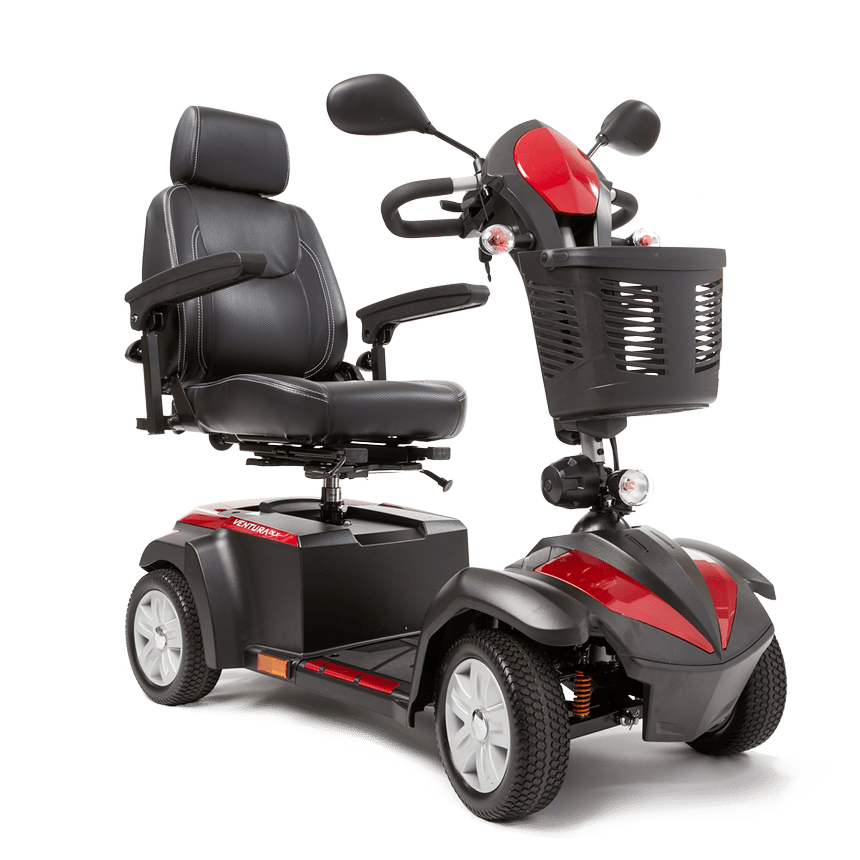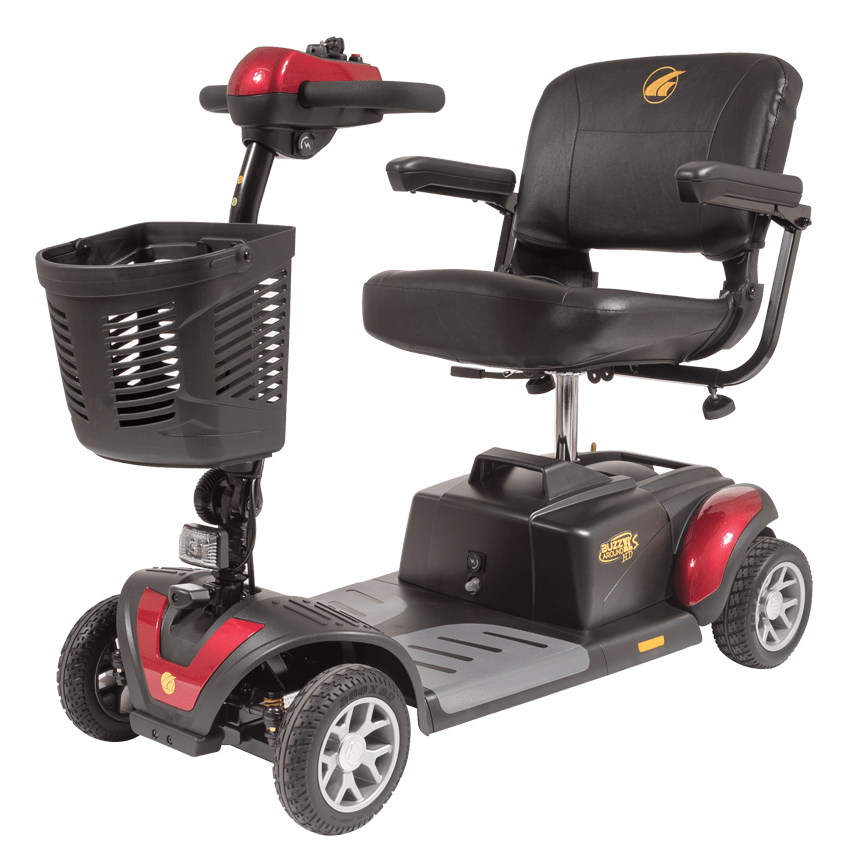4 Wheel Drive Mobility Scooters
Recommendations from TheSeniorList
Check out our team's favorites.
Motorized mobility scooters are meant to be liberating, offering those who have difficulty walking a new path to freedom in the home, office, or anywhere a pedestrian is allowed. Scooters range in size from small foldable models ideal for travel to hefty heavy-duty scooters suited for outdoor use.
Although some countries produce and sell what they list as 4-wheel drive, all-terrain mobility scooters, the U.S. does not. Any website, ad, or salesperson who claims otherwise may be relying on a manufacturer’s definition. In the United States, the terms 4-wheel drive, 4-WD, 4×4, or all-wheel drive — at least when applied to mobility scooters — do not have industry-accepted definitions. Each manufacturer defines these terms as they choose to.
This article will look at what the U.S. does offer in the way of 4-wheel off-road scooters, helping you in your search for the perfect one.

What Makes An Off-Road Mobility Scooter Different?
An off-road mobility scooter, when contrasted with an ordinary 3- or 4-wheel scooter, is substantially bigger and heavier. It will have enhanced shock-absorbing suspension and added power. The superior ground clearance (as much as five inches, higher than an everyday scooter) lets the passenger traverse relatively rough surfaces and negotiate hills, making them ideal for use outside of the home.
The batteries for off-road scooters are bigger and heavier, as well, many of which provide energy for longer trips between charging, as well as higher speeds. The maximum speed for an indoor scooter is around 4 mph, and, depending on the batteries used, the passenger could expect to go eight or more miles on a single charge. Off-road models, like those made by E-Wheels, claim a top possible speed of 15+ mph and — depending on the model — a possible maximum distance of 43 miles.
Both distance and speed will be affected by the combined weight of the passenger and the batteries (those in use as well as any backup batteries for emergencies). Another factor is the drain on the battery of head and tail lights. (LEDs provide bright light while using less battery power). Also, add in whatever else you may be carrying on board. Terrain, weather conditions, tire wear, tire inflation, and battery wear also have an effect.
Why Do I Need A 4-Wheel Drive Scooter?
Anyone who has enjoyed outdoor activities like walking, aerobics, hiking, birdwatching, or photography would understandably be deeply depressed if they could no longer engage in them. If your profession also involves outdoor activity, then there’s an added stressor.
Being cut off from the fresh air, from a creative or lucrative outlet, from the sense of being an active part of a bigger, beautiful, and natural world could cause your quality of life to deteriorate.
Even if you’ve never considered yourself an outdoorsy type, you might consider changing that. This sort of contact and activity can be very stimulating, physically, mentally, and emotionally.
Just being able to accompany others on outdoor activities not only helps to reinforce relationships with them while enlarging your world, but it also reminds you of just how alive and capable you are.
Keep in mind that, as a rule, the most heavy-duty machine can be driven on hiking trails or dirt roads, the soil or mulch should be tight-packed and dry. It’s fine to go onto short grass, so long as it’s dry. Even a humid climate can be damaging. Your salesperson can help you understand what types of mobility scooters will work for your needs and your geographical region.
What To Expect From a 4-Wheel Drive Scooter
The machine you’ll want for off-roading will be a heavy-duty four-wheel scooter with added power, good shock-absorbing suspension, and superior ground clearance. It would also have a supportive seat, bigger tires for increased stability, and greater speed capabilities than standard scooters.
There are 3-wheel off-road scooters, but even though they may be easier to transport and may have more legroom, it’s not worth the sacrifice of that fourth wheel. While it’s still possible to have an accident or even to tip over on a 4-wheeled rig, it’s less likely.
No matter what kind of scooter you’re driving, it’s essential to learn how to handle it and to pay attention when in motion. Always drive a mobility scooter sensibly, with an eye for your safety and that of others.
Before shopping for an off-road scooter, get a sense of the demands of the terrain you want to explore. What could be the steepest inclines or declines, and this includes ramps. One of the specifications of an off-road scooter is the “climbing angle” or “climbing grade.” These terms refer to the steepest incline this scooter’s motor can handle while keeping all four wheels on the ground and avoiding tipping over.
What type of surfaces will you be traversing? How wet is it likely to be? How rough will it be? Will it be stone, dirt-packed or loose — gravel, wet leaves, pine needles? Armed with this information, you can better search online or speak with a knowledgeable salesperson who can help you narrow down your options.
Remember that the maximum stated distance per battery is just that, the maximum. Honest reviews by scooter riders can tell you a lot about what you can reasonably expect. Speaking directly with either a manufacturer’s representative or a salesperson in a brick-and-mortar store may also give you a realistic picture, especially if you go in prepared with solid information and a list of questions.
What To Look For in A 4-Wheel Scooter
The taller or heavier the rider, the more substantial the scooter should be. It is also key that the passenger knows how to ride the scooter. One problem some riders have is leaning too far out of the machine; whether too far forward, backward, or to the side, they run the risk of the machine tipping over. If the machine is too small or lightweight for them, that only increases the likelihood of an accident.
Remember, too, that, rugged as this machine is, batteries and electronic elements (especially the control panel on the tiller steering wheel), are vulnerable to moisture. Some exposure is fine, but just as you should never “hose down” your scooter to clean it, you want to purchase a protective cover to shield it from overexposure to the elements. You can even get a brightly colored rain “poncho” that protects both you and your machine at the same time.

Tips for Purchasing a Mobility Scooter
- Gather as much data as possible about the terrain you’ll be traveling.
- Don’t get into the habit of using more than 50 percent of your charge before recharging. Using more than half the charge on a regular basis wears the batteries out faster.
- The less weight your scooter is carrying, the farther you’ll get on a battery charge.
- Don’t skimp on batteries. A cheap battery may not last long or deliver the reliable power you need.
- Keep track of your tire pressure. As tires deflate, your traction decreases, making soft or slick surfaces that much more dangerous. Also, you get less mileage per charge, the tires wear out faster, and the ride is less comfortable.
- Off-road scooters can be very large and heavy. When it comes to transporting them, some do disassemble, but others do not. The My
- Vita Monster S12X, e.g., is about five feet long and weighs more than 300 lbs. If transporting will be an issue, do you have the right vehicle for that? How many people will you need to handle the process?
Mobility Scooter Features to Consider
A motorized off-road mobility scooter needs to not only be comfortable but also carry whatever it is you need to make your trips both safe and pleasurable. Here are just some of the practical features you want to keep in mind.
- Multi-position seat: This type of seat not only provides comfortable seating options but also makes getting in and out of the scooter easier.
- Suspension system: Is it adequate for the terrain you’ll be traveling?
- Control panel: Is it easy to understand and operate?
- Steering wheel: Is there an ergonomic wraparound handle? Will it work with the user’s dexterity issues?
- Battery indicator: Be sure it is highly visible; the last thing you want is to run out of charge just because you forgot to check it.
- Drivetrain: Is it sufficient to ease the strain on the frame?
- Storage: Are there enough baskets, food storage, general storage units (under the seat or in the form of a trailer to be hauled by the scooter), cup- and phone-holders?
- Phone jack: Keep your phone, tablet, or other small electronic devices charged. The last thing you want is to have your phone die on you!
- Freewheel mode: This option allows easy movement of the scooter even when it’s turned off.
- Head and tail lights: Are there enough of them? Are they well-located and highly visible?
- Reflective tape: Reflective decals and stripes greatly increase your visibility. Reflective coats and hats help too.
How Much Do 4-Wheel Drive Scooters Cost?
Prices range from about $1,600 to upwards of $7,000. The size and weight of the scooter affect the price, as well as the number of features and accessories.
When it comes to selecting a vehicle, don’t just go with the least expensive. That may even be the best choice, but if it isn’t, at the least you’ll have to return it. At the worst, an avoidable accident could result. Take your time to look and ask around. In most cases, retailers will let you test-drive their scooters.
Be clear on return policies, warranties, and consider the value in purchasing an extended warranty.
How Can I Defray The Cost of My Scooter?
Mobility scooters are expensive, although it’s possible to find less expensive options. Unfortunately, Medicare does not help cover the cost of motorized mobility scooters. An everyday scooter can be deducted from your income taxes as a medically “assistive” item if approved by your doctor.
Talk to a tax consultant. Regardless of the outcome of any potential tax deductions, be sure to keep all paperwork relating to correspondence with your doctor and to the purchase of the scooter.
Those who already have a mobility scooter may be able to get a trade-in value at the time of a new purchase. Don’t hesitate to ask the salesperson if they’re interested in this idea.
Summary
Even if there is no genuine all-terrain motorized mobility scooter for seniors in the U.S., there are heavy-duty off-road scooters that grant you the freedom to enjoy the outdoors and to do so safely. The rider, though, must work with the machine, by practicing proper driving technique and paying attention.
Remember that mobility scooters, of whatever type, are meant to make life easier and more pleasurable, but not at the expense of your physical welfare. Do not neglect the advice of your doctor when it comes to exercise or physical therapy. The point is, use a scooter when it’s practical but do what you need to do to maintain your body and overall quality of life.




